3D printers
High quality 3D printers
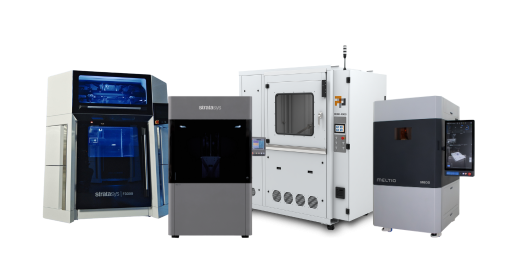
Compared to plastic processes, metal 3D printing is much younger, having been developed in the late 1990s and commercialised in the mid-2000s. However, it now has a considerable portfolio of different alloys that can be processed using additive manufacturing.
The now widely grown subcategories of metal 3D printing, which work either with a laser, a binder or by extrusion, impress above all with unlimited design freedom, an isotropic microstructure and excellent series production capacities – regardless of the material used.
But this blog post is about these materials and how their diverse properties, both mechanical and thermal, physical and chemical, contribute to a wide range of uses in a variety of industries and applications.
We will divide the materials into two main categories. First, steel-based alloys, which include stainless and tool steels, and second, speciality alloys, which include alloys made of copper, nickel, titanium and cobalt-chromium.

Steel is one of the most versatile engineering materials, and its production exceeds that of all other metallic materials combined by more than ten times. It is therefore not surprising that steel-based alloys now also account for a very large proportion of 3D printing production.
In this category, we will look at the four most commonly used steel-based alloys – 17-4 PH stainless steel, 316L stainless steel, D2 tool steel and H13 tool steel – starting with the champion of strength among stainless steels.
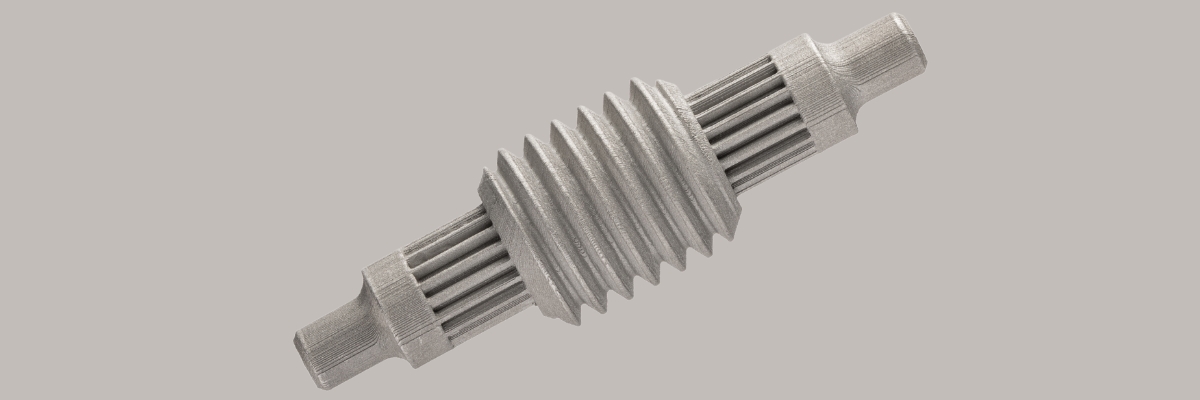
17-4 PH is a martensitic stainless steel alloy that, in addition to steel, consists mainly of chromium (approx. 17%) and nickel (approx. 4%), hence the designation 17-4. The ‘PH’, in turn, stands for ‘precipitation hardening’, which describes the type of heat treatment of this material.
This stainless steel is particularly popular due to its excellent strength and moderate hardness. The tensile strength of 17-4 PH after appropriate heat treatment is up to 1,030 MPa and the hardness can be up to 40 HRC (Rockwell hardness – scale C).
In addition, it is characterised by good corrosion resistance, including in seawater and chemical environments, good weldability and comparatively easy printability.
However, 17-4 PH has to admit defeat to other metals, especially when it comes to heat resistance. 17-4 PH is only stable at temperatures between 300 and 400 °C, which is well below many other materials used in metal 3D printing. 17-4 PH is also relatively expensive, costing between €80 and €200 per kilogram, and post-processing can be difficult due to its high strength and hardness.
A major field of application in which 17-4 PH is frequently used is aviation. The combination of excellent strength and good corrosion resistance is ideal for components such as structural brackets, hydraulic pistons and cylinders, and much more.
Other applications include the oil and gas industry, where drilling tools, pump components and valves, among other things, can be additively manufactured, and the energy sector, with applications such as rotors and bearings for steam turbines.
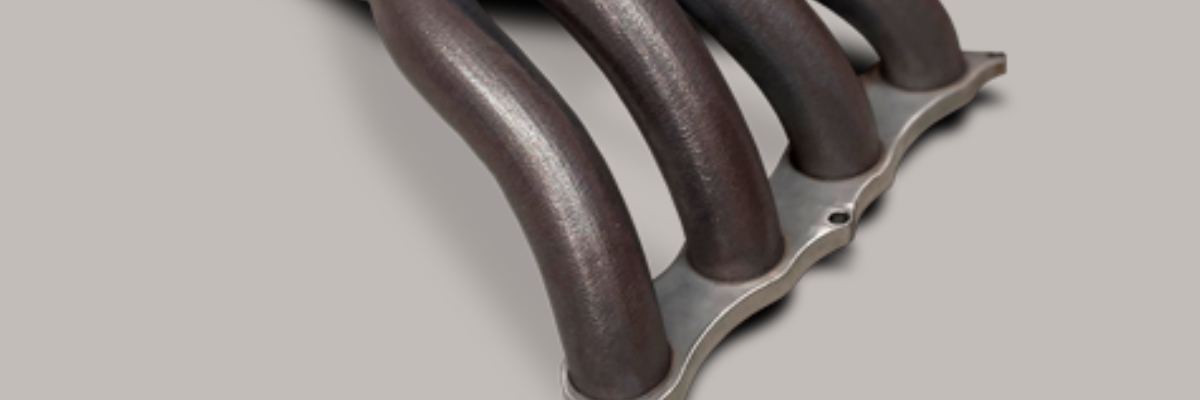
The 316L stainless steel is austenitic and consists mainly of steel, with about 16% chromium, about 12% nickel and about 3% molybdenum. The ‘L’ in 316L stands for ‘low carbon’ because 316L contains a maximum of 0.03% carbon.
The greatest advantage of 316L is its exceptional corrosion resistance. The high chromium and nickel content, as well as the addition of molybdenum, means that 316L is particularly well protected against corrosion by salt and seawater, but also against chloride-induced corrosion, as well as acids and bases. Due to the very low carbon content, 316L is also perfectly protected against intercrystalline corrosion and crevice corrosion.
In addition, 316L is very easy to weld, has an excellent heat resistance of up to 870°C and offers a moderate hardness of 25 to 30 HRC. It is also relatively inexpensive, costing between 60 and 150 per kilogram. Furthermore, it is also comparatively easy to print and, thanks to its lower hardness, easier to rework.
However, 316L cannot keep up with other steel-based alloys in terms of strength. With a tensile strength of around 550 MPa, it tends to deform or crack under high tensile stress. In addition, 316L loses its ductility at very low temperatures, which leads to higher brittleness and thus excludes certain areas of application.
One area of application that is not ruled out altogether, however, is the chemical industry. Here, 316L excels thanks to its outstanding corrosion resistance and good hardness in applications such as pipelines, pumps, valves, containers and condensers.
316L is also used in the shipping industry as a material for corrosion protection systems. In addition, 316L is very popular in the oil and gas industry, in energy and environmental technology, and in the agricultural sector.
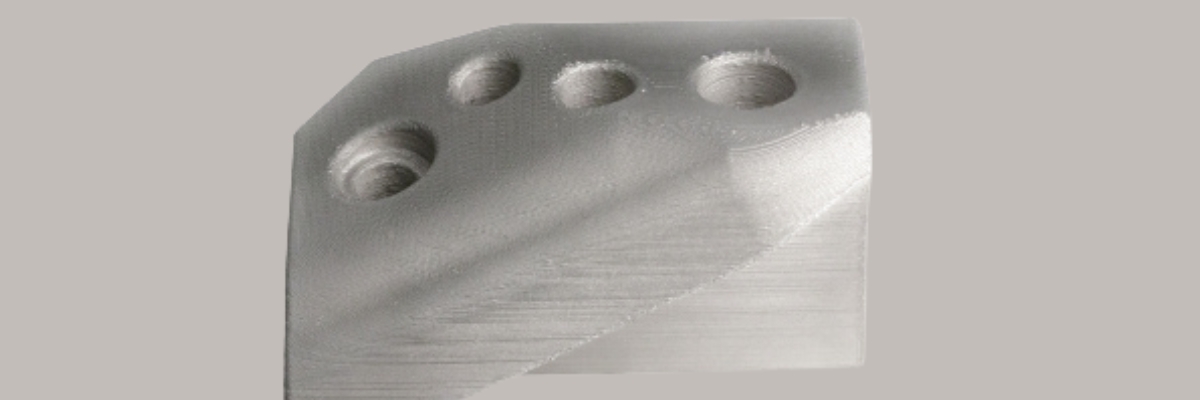
D2 is a high-alloy tool steel alloy with a high chromium content of approx. 12% and a high carbon content of approx. 1.5%, as well as silicon, manganese and vanadium.
This tool steel is characterised by its exceptional hardness of up to 60 HRC, which ensures outstanding wear and abrasion resistance, and excellent tensile strength of up to 1,500 MPa.
In addition, D2 tool steel offers good heat resistance of up to 500°C, is known for its extraordinary durability and, at 80 to 160 euros per kilogram, its costs are in the mid-range.
However, D2 is not particularly corrosion resistant and tends to rust if not stored correctly. Furthermore, it is relatively difficult to print and to rework and can only be welded using special processes and with special precautions.
Due to its use as a tool steel, it is clear that tool production is the main application for this material. D2 is particularly suitable for cutting and punching tools and moulds thanks to its very high wear and abrasion resistance.
But D2 is also perfect for precision tools that are subject to high mechanical loads due to its tensile strength and hardness. D2 is also frequently used for tool series production due to its long service life.
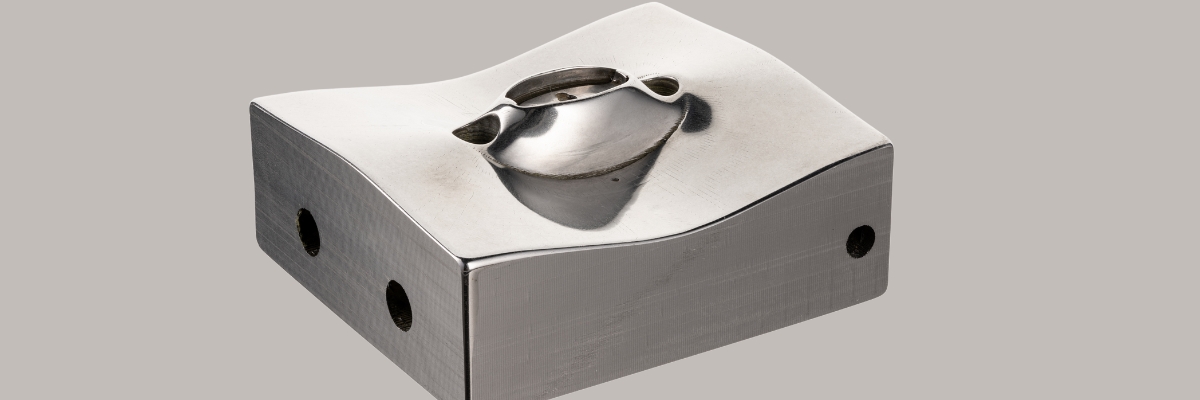
With the H13 tool steel, we have another high-alloy tool steel alloy, which, however, has a much lower chromium content of only about 5% and also a lower carbon content of about 0.4%. The other components are molybdenum, silicon, vanadium, manganese and a very small amount of sulfur and phosphorus.
Compared to D2, H13 particularly excels with an increased heat resistance of up to 550°C, which is why H13 is very popular for high-temperature applications. At up to 1,400 MPa, tensile strength is also undoubtedly in the Champions League.
Furthermore, H13 also offers a high hardness of 54 to 56 HRC, which, although it is slightly lower than D2, still offers very good protection against abrasion and wear, and is not as prone to rust as D2, although H13 does not shine when it comes to corrosion resistance either.
The other disadvantages of H13 tool steel are the same as those of D2 tool steel. Difficult printing conditions and post-processing, and not easy to weld, as H13 tends to warp and crack during the welding process. In addition, the price is between 120 and 250 euros per kilogram, which is quite a bit higher than the price of D2.
Of course, H13 is also used primarily for tool production. However, its main focus is on casting and die-casting tools, where the high temperature resistance of H13 can be fully utilised.
H13 is also very popular for metalworking, since here, too, the tools are subject to high thermal and mechanical stresses. One industry that makes very frequent use of H13 tool steel to manufacture high-performance tools is the automotive industry.
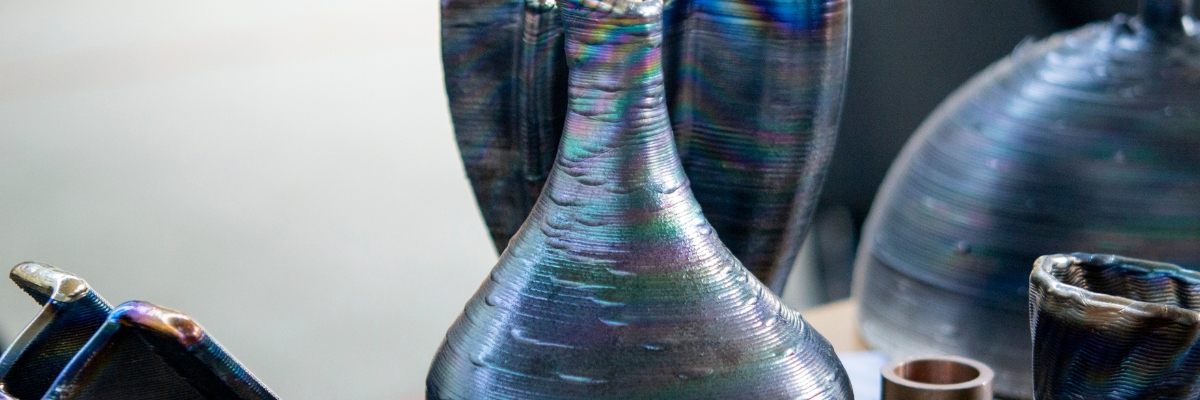
While steel-based alloys account for a large proportion of metal 3D printing, there are now also a variety of special alloys that can be processed using additive manufacturing and offer better properties for certain requirements.
In this category, we will look at five different alloys – Ti-6Al-4V, Inconel 625, Inconel 718, copper and CoCrMo, starting with the material for an excellent strength-to-weight ratio.
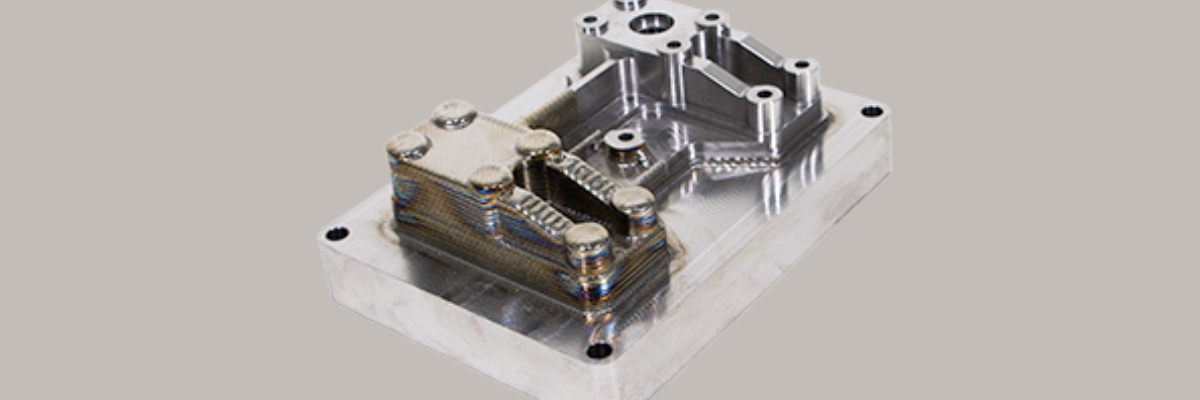
Ti-6Al-4V, also known as Grade 5 titanium, is the most common titanium alloy in both classic and additive manufacturing. It consists of approximately 90% titanium, approximately 6% aluminium and approximately 4% vanadium, which is completed with a small amount of iron, oxygen and carbon.
This titanium alloy impresses with its excellent strength and low weight, thanks to its low absolute density of around 4.43 g/cm³. The typical tensile strength is between 900 and 1,200 MPa, making it ideal for manufacturing lightweight components that can withstand mechanical stress.
In addition, Ti-6Al-4V offers excellent corrosion resistance, including seawater, is biocompatible, offers moderately high hardness of up to 38 HRC, and is relatively easy to weld, although care must be taken to ensure an oxygen-free environment to avoid brittle spots.
However, Ti-6Al-4V only offers moderate heat resistance of around 400°C, is challenging to print and rework, and is one of the most expensive metals for 3D printing, costing between €250 and €500 per kilogram.
Thanks to its excellent strength-to-weight ratio, Ti-6Al-4V has become the material of choice in the aerospace industry for weight optimisation. The combination of the material's low weight and the maximised design freedom of 3D printing makes it possible to produce lightweight yet mechanically resilient wing frames, fairings, fuselage components, compressor blades and landing gear parts.
Other industries that benefit from the properties of Ti-6Al-4V include the automotive, maritime, defence, energy, chemical and petrochemical industries.

One of two very popular nickel alloys used in 3D printing is Inconel 625. Inconel 625 consists of approximately 58% nickel, 22% chromium, 8% molybdenum, 5% iron, 4% niobium and other trace elements such as manganese, silicon and carbon.
Inconel 625 is particularly known for its outstanding temperature resistance of up to 980 °C, which is complemented by excellent oxidation resistance and high tensile strength of up to 1,100 MPa.
This nickel alloy also boasts excellent corrosion resistance even under very aggressive conditions, relatively good formability, both cold and hot, despite its high strength, a moderate price between 80 and 200 euros per kilogram, a moderate hardness of approx. 35 HRC and good weldability.
In contrast to the aforementioned Ti-6Al-4V, however, Inconel 625 has a relatively high density of around 8.4 g/cm³, which disqualifies it for applications with strict weight requirements. Printing and post-processing the material is also more complex than with stainless steels, for example, where higher tool wear can occur, especially during post-processing.
One industry that relies on Inconel 625 very frequently is the energy sector. Inconel 625 is used in both conventional and nuclear power plants for heat exchangers, control rods, piping and boiler components, among other things. This material is also popular for offshore oil and gas platforms due to its excellent corrosion resistance.
In addition, Inconel 625 is also used in the chemical and process industry, for example for heat exchangers and pump components, in welding technology, for example for welding rods and electrodes, and in the maritime industry, for example for propellers and fittings.

The second most popular nickel alloy in additive manufacturing is Inconel 718. This material has a lower nickel and chromium content, approx. 53 and approx. 19 %, but a high iron content of approx. 18 % and other elements such as niobium, tantalum, molybdenum, titanium and aluminium in smaller quantities.
Inconel 718 outperforms Inconel 625, particularly in terms of strength and yield strength. Inconel 718 has a tensile strength of up to 1,400 MPa and an exceptional yield strength of 1,100 MPa, compared to up to 700 MPa for Inconel 625.
Inconel 718 also has excellent creep and fatigue resistance, even at high temperatures. Speaking of temperatures, Inconel 718‘s heat resistance is lower than Inconel 625’s at up to 700°C, but it is still very high and good enough for most high-temperature applications. Inconel 718 is also relatively easy to form and weld, despite its very high strength and moderate hardness of approx. 35 HRC, which can be increased to up to 50 by hardening.
Inconel 718 also has a relatively high density of approx. 8.19 g/cm³, which makes it unsuitable for lightweight components. It is also complex to print and rework, costs between 120 and 250 euros per kilogram, and despite its excellent corrosion resistance, it is susceptible to stress corrosion cracking, especially when it comes into contact with chlorides.
Inconel 718 is able to withstand not only high but also very low temperatures, which is why it has secured a unique place for itself in the aerospace industry. Here, for example, it is used in rocket engines for components such as combustion chambers, nozzle blades and brackets.
The properties of Inconel 718 are also frequently required in the oil and gas industry, aviation, the automotive industry, the chemical industry, shipping and in tool and mould making, which is why it is also frequently used in these sectors.

Copper is a very versatile metal that is becoming increasingly important in the 3D printing industry. Copper can be used in its pure form or as bronze (copper-tin) and brass (copper-zinc), although we will focus on the pure form in this blog post.
The increasing importance of copper is mainly due to its conductivity. Copper has both outstanding thermal conductivity, typically around 390 to 400 W/mK, and excellent electrical conductivity of around 59.6 × 10^6 S/m (Siemens per metre), second only to silver among metals.
Copper also has antimicrobial properties, which kill potentially harmful microorganisms, which is of the utmost importance in medical technology. It is also very corrosion-resistant, easy to weld and work, and, at a price of 30 to 80 euros per kilogram, very cost-effective.
However, with a tensile strength of 200 to 400 MPa, copper is one of the softest materials in terms of strength, which excludes certain areas of application. Furthermore, it is difficult to print with lasers due to its thermal conductivity, as it absorbs the energy of the laser poorly. To process copper with laser printing technologies, very powerful printing systems and precise process parameters are therefore required.
Thanks to its excellent electrical conductivity, copper is frequently used in the electronics industry. Additive manufacturing can be used to produce components such as printed circuit boards, transformers, coils, heat sinks and many more.
Other areas of application for copper include the water and wastewater industry, where pipes, valves and fittings can be produced, the automotive industry, for example for radiator hoses and brake components, and the chemical industry, for applications such as catalysts and containers.

CoCrMo, or cobalt-chromium-molybdenum, is a relatively new alloy in 3D printing, but its range of applications is constantly expanding. In addition to the metals from which it gets its name, CoCrMo also contains trace elements of nickel, carbon, manganese and silicon.
This material is characterised by an extraordinary combination of very high hardness (up to 55 HRC after sufficient heat treatment), corrosion resistance (including resistance to bodily fluids) and biocompatibility (no toxic reactions on or in the human body).
In addition, CoCrMo offers high strength, with a tensile strength of about 1,200 MPa and an elongation limit of up to 900 MPa, outstanding heat resistance of up to 1,000°C, as well as high durability and wear resistance.
CoCroMo is relatively complex to print and requires very strong lasers. The material cannot be welded and is difficult to rework. It quickly becomes brittle at low temperatures and has relatively low ductility. With a price between 150 and 350 euros per kilogram, it is one of the more expensive options.
Thanks to its biocompatibility and corrosion resistance to bodily fluids, CoCroMo has made a name for itself in medical technology in particular. In combination with 3D printing, this material enables the rapid and patient-specific production of hip and knee prostheses, dental implants, dental bridges and surgical instruments.
The high heat resistance of CoCrMo also offers a wide range of applications in industries such as automotive, aerospace, tool and mould making, chemical and process industries, as well as in welding technology.
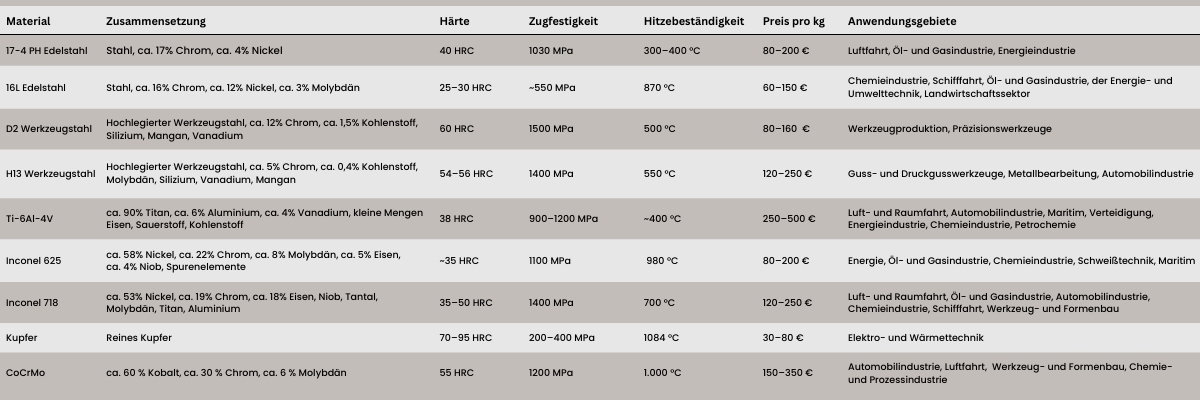
Even though metal 3D printing is the youngest form of additive manufacturing to date, it now offers a wide range of materials with a wide variety of properties and applications, enabling it to demonstrate its advantages in a number of different industries.
I hope that this blog post has provided a useful overview of the various metals, their advantages and disadvantages, and the perfect applications for them.
This brings us to the end of this blog series on the materials used in additive manufacturing. However, this blog will continue to keep you informed about new developments in 3D printing in the future – be it materials, printing technologies or applications.
Thank you for reading – and see you in the next blog post!